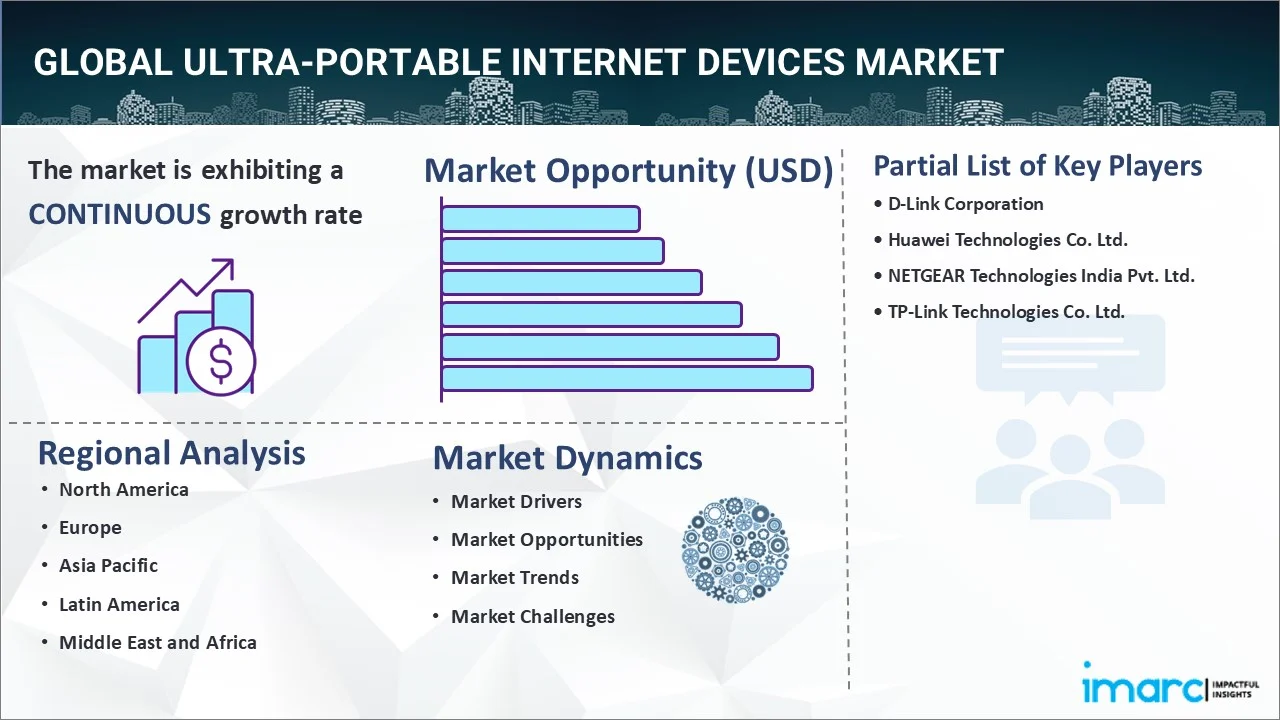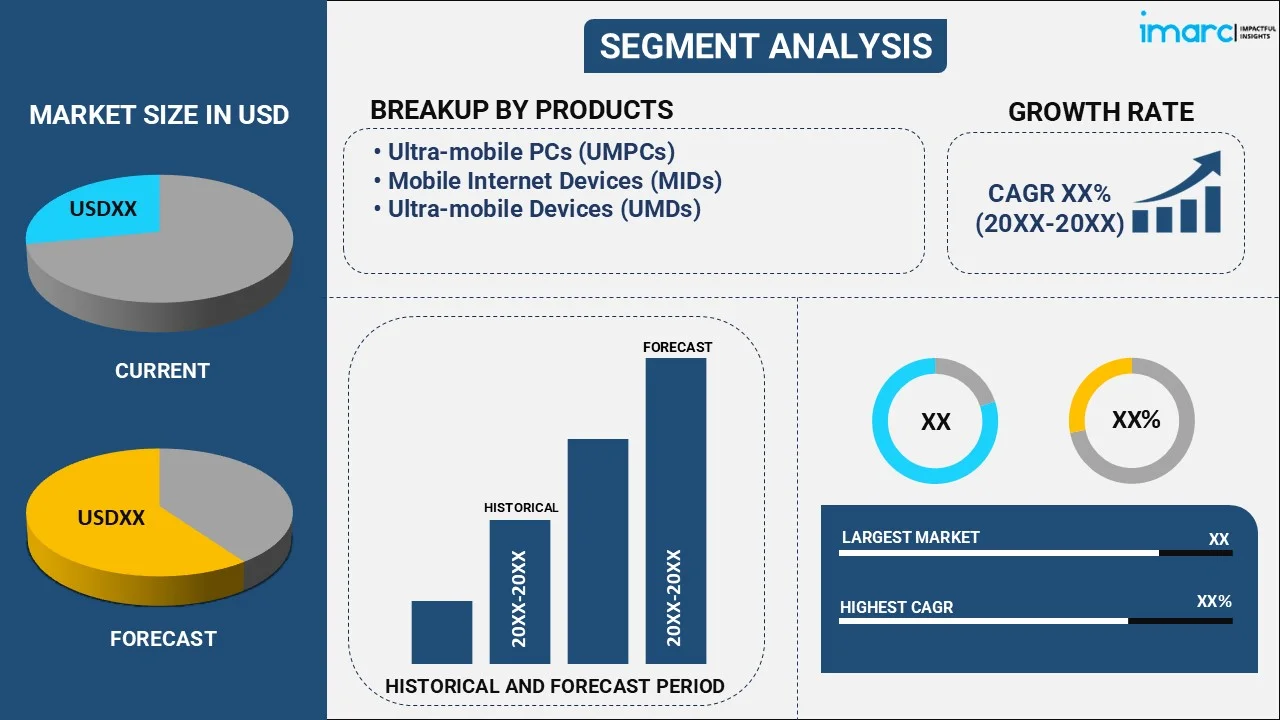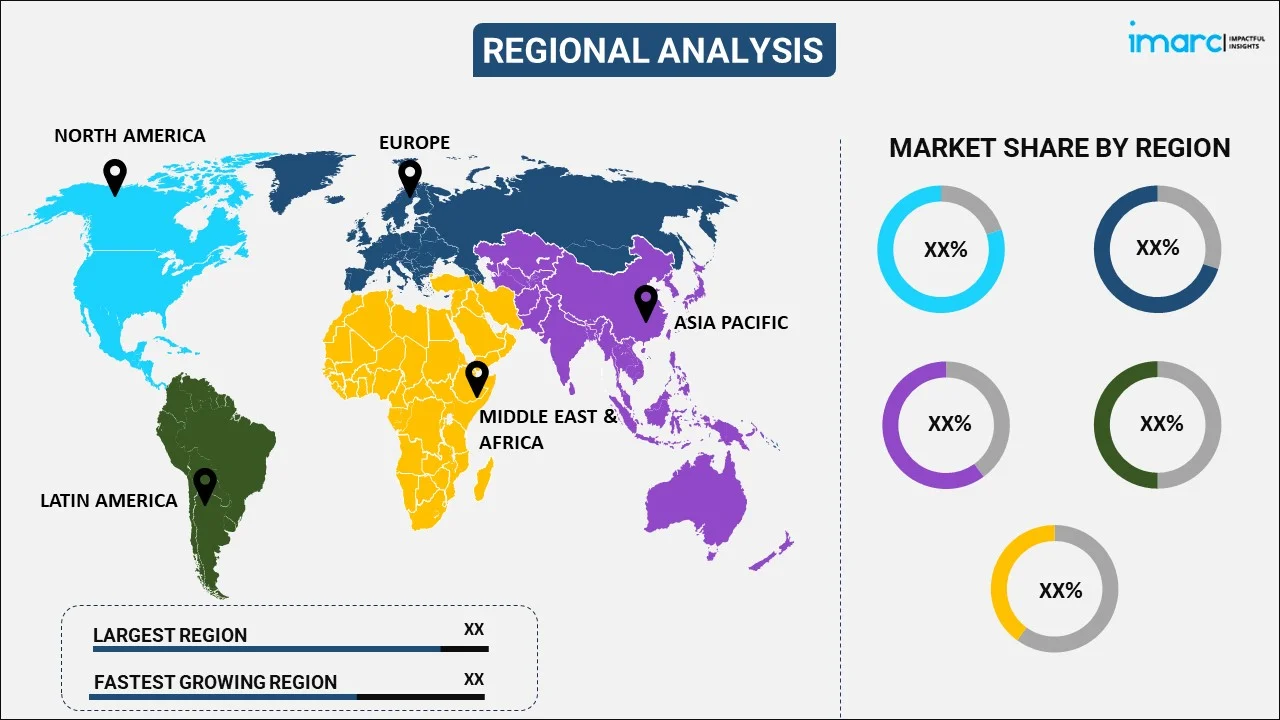
Ultra-Portable Internet Devices Market Report by Product (Ultra-mobile PCs (UMPCs), Mobile Internet Devices (MIDs), Ultra-mobile Devices (UMDs)), Application (Personal Use, Commercial Use), and Region 2025-2033
Market Overview:
The global ultra-portable internet devices market size reached USD 25.0 Billion in 2024. Looking forward, IMARC Group expects the market to reach USD 42.4 Billion by 2033, exhibiting a growth rate (CAGR) of 5.43% during 2025-2033. The increasing demand for connectivity, rapid technological advancements, changing consumer lifestyles, increasing penetration of UPIDs in developing regions, advent of the Internet of Things (IoT), and the introduction of various digital literacy campaigns by governments are some of the major factors propelling the market.
|
Report Attribute
|
Key Statistics |
|---|---|
|
Base Year
|
2024 |
|
Forecast Years
|
2025-2033
|
|
Historical Years
|
2019-2024
|
| Market Size in 2024 | USD 25.0 Billion |
| Market Forecast in 2033 | USD 42.4 Billion |
| Market Growth Rate (2025-2033) | 5.43% |
Ultra-portable internet devices (UPIDs) refer to small, lightweight devices designed to provide internet access on the go. They include smartphones, tablets, and netbooks, encompassing components such as processors, memory, displays, and connectivity modules, including Wi-Fi or mobile data. UPIDs are widely used for web browsing, email access, social media interaction, video streaming, online banking, remote work, mobile gaming, health monitoring, navigation, and home automation control. They are cost-effective and reliable devices that increase convenience, provide instant connectivity, improve accessibility to cloud services, enhance productivity, and offer personalized user experience.

The increasing penetration of UPIDs in developing regions, owing to the improved internet infrastructure, is positively influencing the market growth. Furthermore, the advent of the Internet of Things (IoT), which is facilitating the integration of UPIDs with smart devices within homes and industries, is boosting the market growth. Apart from this, the introduction of various digital literacy campaigns by governments across the globe to encourage the uptake of UPIDs, especially in rural and underserved regions, is fueling the market growth. Moreover, the implementation of competitive pricing strategies, coupled with the availability of diverse models, which have made UPIDs accessible to a broader spectrum of consumers, is contributing to the market growth. Additionally, the rapid expansion of the e-commerce sector, which has resulted in more consumers requiring devices for online shopping, is positively influencing the market growth.
Ultra-Portable Internet Devices Market Trends/Drivers:
The increasing demand for connectivity
The increasing requirement for continuous and instant internet connectivity in the modern era is propelling the market growth. Along with this, the growing user reliance on internet connectivity for business communication, personal interaction, information retrieval, and entertainment is positively influencing the market growth. In line with this, UPIDs serve as a vital link in ensuring that the various connectivity needs of consumers are met without spatial restrictions. Furthermore, they allow users to access the internet and stay connected, irrespective of their location. Apart from this, the increasing globalization of industries, coupled with the rapid expansion of online platforms, which require uninterrupted connectivity, is boosting the market growth. Moreover, the growing device adoption to support seamless communication across various time zones and cultures is fueling the market growth.
The rapid technological advancements
The technological evolution within the sphere of ultra-portable internet devices (UPIDs) is a critical aspect propelling the market growth. In line with this, the advancements in core components, such as processors, memory, and display technology, which have transformed UPIDs into powerful tools that rival traditional computing devices, are boosting the market growth. Furthermore, the improvements in energy efficiency, which enable prolonged battery life and enhance the ecological appeal of these devices, are supporting the market growth. Additionally, the recent innovations in touch-screen technology, user-interface design, and hardware aesthetics that have broadened the devices’ appeal across various demographics are positively influencing the market growth. Moreover, the increasing collaboration between hardware manufacturers, software developers, and telecom providers to create an ecosystem that continually pushes the envelope of what UPIDs can achieve is favoring the market growth.
The changing consumer lifestyle
The proliferation of UPIDs can be largely attributed to a shift in consumer lifestyles that emphasizes mobility, flexibility, and digital engagement. Furthermore, remote working has emerged as a norm, which is demanding devices that enable professionals to work from any location and time zone. Additionally, the rising number of social media and digital entertainment platforms resulting in an unprecedented focus on mobile connectivity is strengthening the market growth. In line with this, UPIDs facilitate the consumption of content and social interaction without the constraints of a stationary setup. Moreover, the escalating health consciousness and fitness trends, which have led to the integration of UPIDs with wearable technology for tracking and monitoring purposes, are contributing to the market growth.
Ultra-Portable Internet Devices Industry Segmentation:
IMARC Group provides an analysis of the key trends in each segment of the global ultra-portable internet devices market report, along with forecasts at the global, regional, and country levels from 2025-2033. Our report has categorized the market based on product and application.
Breakup by Product:

- Ultra-mobile PCs (UMPCs)
- Mobile Internet Devices (MIDs)
- Ultra-mobile Devices (UMDs)
Ultra-mobile PCs (UMPCs) holds the largest market share.
The report has provided a detailed breakup and analysis of the ultra-portable internet devices market based on the product. This includes ultra-mobile PCs (UMPCs), mobile internet devices (MIDs), and ultra-mobile devices (UMDs). According to the report, ultra-mobile PCs (UMPCs) represented the largest market segment.
Ultra-mobile PCs (UMPCs) are dominating the market as they offer a high degree of performance, encapsulating features similar to those of conventional PCs. Furthermore, their robust processors, ample memory, and advanced graphics capabilities enable users to engage in tasks that might be challenging for other portable devices. Additionally, UMPCs provide a multifunctional platform that allows users to switch between work and entertainment, thus catering to a wide array of needs. Apart from this, they offer full-sized keyboards, larger displays, and various connectivity options that appeal to both casual users and professionals. Moreover, the recent advancements in battery technology, which allowed UMPCs to operate for extended periods without recharging, are propelling the market growth. In addition, UMPCs offer the ability to connect with various peripherals, such as printers, external hard drives, and monitors.
Breakup by Application:
- Personal Use
- Commercial Use
Commercial Use holds the largest market share.
The report has provided a detailed breakup and analysis of the ultra-portable internet devices market based on application. This includes personal and commercial use. According to the report, commercial use represented the largest market segment.
Commercial use is dominating the market as employees are often required to work remotely or while on the move. In line with this, ultra-portable internet devices provide the necessary connectivity and functionality to support this demand. Furthermore, these devices are more affordable compared to traditional computing equipment, which aids businesses in significantly saving costs. Apart from this, ultra-portable devices are designed to seamlessly integrate with business applications and tools, enabling efficient collaboration and data sharing. Besides this, the portability and convenience of these devices allow employees to remain connected and productive, even when they are away from the office. Additionally, several manufacturers offer customization options that allow businesses to tailor devices to their specific needs. This can include aspects such as security features, software integration, and other specifications tailored for commercial use.
Breakup by Region:

- North America
- United States
- Canada
- Europe
- Germany
- France
- United Kingdom
- Italy
- Spain
- Others
- Asia Pacific
- China
- Japan
- India
- South Korea
- Australia
- Indonesia
- Others
- Latin America
- Brazil
- Mexico
- Others
- Middle East and Africa
North America exhibits a clear dominance in the market, accounting for the largest ultra-portable internet devices market share.
The report has also provided a comprehensive analysis of all the major regional markets, which includes North America (the United States and Canada); Europe (Germany, France, the United Kingdom, Italy, Spain, and others); Asia Pacific (China, Japan, India, South Korea, Australia, Indonesia, and others); Latin America (Brazil, Mexico, and others); and the Middle East and Africa. According to the report, North America accounted for the largest market share.
The presence of multiple technology companies and a robust digital infrastructure in North America, which supports innovation, is propelling the market growth. Along with this, the region hosts several key players in the technology sector, including manufacturers and software developers of ultra-portable devices, which results in earlier launches and deeper market penetration. Besides this, the increasing affluence and technological awareness among consumers in North America, which creates a strong demand for the latest gadgets and internet devices, is boosting the market growth. Moreover, the introduction of favorable regulations by the regional governments that support the growth and innovation of technology companies is positively influencing the market growth. Furthermore, the presence of well-established retail and online distribution networks in North America, which ensure that products are readily available to consumers, is fueling the market growth.
Competitive Landscape:
The leading UPID companies are developing advanced products with enhanced battery life, improved processing speed, and superior display quality. In addition, several key players are broadening their global reach by collaborating with local distributors and retailers. Apart from this, many leading firms are extending their product lines to cater to different segments of consumers, including high-end models for professionals and budget-friendly options for general consumers. Additionally, companies are developing products that resonate with the target audience. This includes personalized experiences, user-friendly interfaces, and responsive customer support. Moreover, they are adopting sustainable practices in manufacturing and recycling to attract eco-conscious consumers. Along with this, leading companies are forming alliances with software developers, content providers, and network carriers to create a seamless user experience.
The report has provided a comprehensive analysis of the competitive landscape in the global ultra-portable internet devices market. Detailed profiles of all major companies have also been provided. Some of the key players in the market include:
- D-Link Corporation
- Huawei Technologies Co. Ltd.
- NETGEAR Technologies India Pvt. Ltd.
- TP-Link Technologies Co. Ltd.
Ultra-Portable Internet Devices Market Report Scope:
| Report Features | Details |
|---|---|
| Base Year of the Analysis | 2024 |
| Historical Period | 2019-2024 |
| Forecast Period | 2025-2033 |
| Units | Billion USD |
| Scope of the Report | Exploration of Historical and Forecast Trends, Industry Catalysts and Challenges, Segment-Wise Historical and Predictive Market Assessment:
|
| Products Covered | Ultra-mobile PCs (UMPCs), Mobile Internet Devices (MIDs), Ultra-mobile Devices (UMDs) |
| Applications Covered | Personal Use, Commercial Use |
| Regions Covered | Asia Pacific, Europe, North America, Latin America, Middle East and Africa |
| Countries Covered | United States, Canada, Germany, France, United Kingdom, Italy, Spain, China, Japan, India, South Korea, Australia, Indonesia, Brazil, Mexico |
| Companies Covered | D-Link Corporation, Huawei Technologies Co. Ltd., NETGEAR Technologies India Pvt. Ltd., TP-Link Technologies Co. Ltd. |
| Customization Scope | 10% Free Customization |
| Post-Sale Analyst Support | 10-12 Weeks |
| Delivery Format | PDF and Excel through Email (We can also provide the editable version of the report in PPT/Word format on special request) |
Key Questions Answered in This Report:
- How has the global ultra-portable internet devices market performed so far, and how will it perform in the coming years?
- What are the drivers, restraints, and opportunities in the global ultra-portable internet devices market?
- What is the impact of each driver, restraint, and opportunity on the global ultra-portable internet devices market?
- What are the key regional markets?
- Which countries represent the most attractive ultra-portable internet devices market?
- What is the breakup of the market based on the product?
- Which is the most attractive product in the ultra-portable internet devices market?
- What is the breakup of the market based on application?
- Which is the most attractive application in the ultra-portable internet devices market?
- What is the competitive structure of the global ultra-portable internet devices market?
- Who are the key players/companies in the global ultra-portable internet devices market?
Key Benefits for Stakeholders:
- IMARC’s report offers a comprehensive quantitative analysis of various market segments, historical and current market trends, market forecasts, and dynamics of the ultra-portable internet devices market from 2019-2033.
- The research study provides the latest information on the market drivers, challenges, and opportunities in the global ultra-portable internet devices market.
- The study maps the leading, as well as the fastest-growing, regional markets. It further enables stakeholders to identify the key country-level markets within each region.
- Porter's five forces analysis assist stakeholders in assessing the impact of new entrants, competitive rivalry, supplier power, buyer power, and the threat of substitution. It helps stakeholders to analyze the level of competition within the ultra-portable internet devices industry and its attractiveness.
- Competitive landscape allows stakeholders to understand their competitive environment and provides an insight into the current positions of key players in the market.
Need more help?
- Speak to our experienced analysts for insights on the current market scenarios.
- Include additional segments and countries to customize the report as per your requirement.
- Gain an unparalleled competitive advantage in your domain by understanding how to utilize the report and positively impacting your operations and revenue.
- For further assistance, please connect with our analysts.
 Request Customization
Request Customization
 Speak to an Analyst
Speak to an Analyst
 Request Brochure
Request Brochure
 Inquire Before Buying
Inquire Before Buying




.webp)




.webp)












